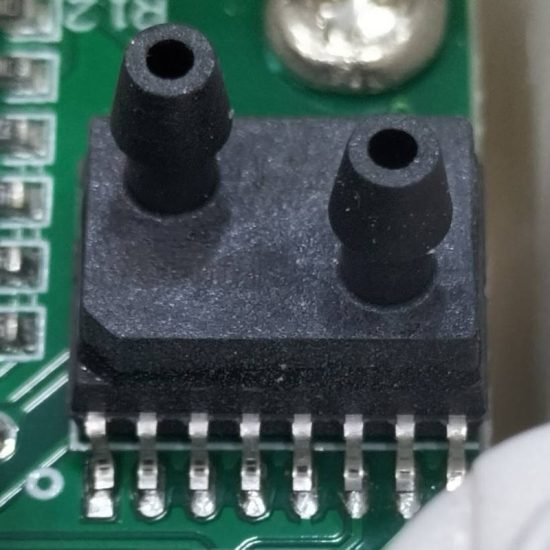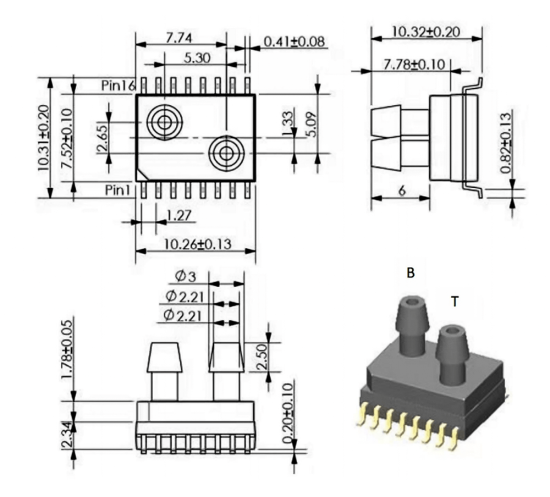Catalogare
I ventilatori fungono da dispositivi di supporto vitale in cui il funzionamento stabile è direttamente correlato alla sicurezza del paziente. Il sensore di pressione medicale WF200DP garantisce la perfetta sincronizzazione tra l'apparecchiatura e i modelli respiratori del paziente attraverso il monitoraggio preciso della pressione delle vie aeree e il controllo del feedback in tempo reale. Questo sensore di pressione differenziale basato su MEMS è diventato un componente fondamentale indispensabile nei moderni sistemi di ventilazione grazie alla sua elevata precisione, risposta rapida e stabilità a lungo termine.
1. Ruolo critico della tecnologia MEMS nei ventilatori
Importanza medica del monitoraggio della pressione
I ventilatori creano differenziali di pressione artificiali per sostituire la funzione respiratoria naturale. Durante la respirazione normale, l'inspirazione crea una pressione negativa attraverso l'espansione del torace, mentre l'espirazione genera una pressione positiva attraverso la contrazione elastica alveolare. Il sensore WF200DP replica con precisione questo processo fisiologico, garantendo una valutazione accurata delle esigenze respiratorie del paziente attraverso il monitoraggio della pressione delle vie aeree in tempo reale.
Principi di rilevamento della pressione differenziale
WF200DP utilizza la tecnologia di rilevamento della pressione differenziale, monitorando simultaneamente le differenze di pressione tra due porte. Questo design consente al sensore di eliminare le variazioni della temperatura ambientale e della pressione atmosferica, fornendo risultati di misurazione più stabili e accurati. I diaframmi interni in silicio subiscono piccole deformazioni sotto pressione, convertendo i segnali meccanici in segnali elettrici attraverso effetti piezoresistivi.
Elaborazione del segnale e feedback di controllo
I segnali analogici generati dal sensore vengono sottoposti ad amplificazione e conversione digitale prima della trasmissione all'unità microcontrollore del ventilatore. L'MCU analizza i dati di pressione per valutare lo stato respiratorio del paziente, regolando la velocità del motore e le aperture delle valvole per controllare l'alimentazione e lo scarico del flusso d'aria, ottenendo una sincronizzazione precisa con la respirazione del paziente.

2. Vantaggi tecnici del sensore WF200DP
Capacità di misurazione ad alta precisione
I sensori WF200DP presentano una precisione di misurazione pari a ±0,25%, rilevando variazioni di pressione estremamente minime. Questo livello di precisione si rivela fondamentale per le applicazioni di ventilazione, poiché le variazioni della pressione respiratoria del paziente spesso coinvolgono solo centinaia di pascal, richiedendo una sensibilità del sensore sufficiente per catturare con precisione queste variazioni.
Caratteristiche di risposta rapida
I tempi di risposta del sensore inferiori a 1 millisecondo consentono il monitoraggio in tempo reale dei rapidi cambiamenti del ciclo respiratorio del paziente. Questa capacità di risposta rapida garantisce che i ventilatori possano regolare tempestivamente i parametri di uscita, prevenendo il disagio del paziente o la ridotta efficacia del trattamento a causa di ritardi.
Garanzia di stabilità a lungo termine
Le apparecchiature mediche richiedono in genere un funzionamento continuo per migliaia di ore. I sensori WF200DP sono sottoposti a test approfonditi di stabilità a lungo termine, con deriva del punto zero e deriva a fondo scala controllate entro intervalli minimi, garantendo una precisione di misurazione costante durante periodi di utilizzo prolungati.
3. Integrazione e controllo del sistema di ventilazione
Monitoraggio collaborativo multiparametrico
I moderni ventilatori monitorano non solo la pressione ma anche il flusso, la temperatura, l’umidità e altri parametri. I sensori WF200DP funzionano in collaborazione con altri sensori, fornendo un monitoraggio completo dei parametri fisiologici per la sicurezza e l'efficacia del trattamento.
Algoritmi di controllo intelligente
I dati del sensore vengono inseriti in algoritmi di controllo avanzati che consentono il riconoscimento automatico del pattern respiratorio del paziente e la regolazione della frequenza respiratoria, del volume corrente e dei parametri di pressione positiva di fine espirazione. Questo controllo intelligente riduce significativamente il carico di lavoro del personale sanitario migliorando al tempo stesso i risultati del trattamento.
Meccanismi di protezione della sicurezza
Quando i sensori rilevano valori di pressione anomali, i ventilatori attivano immediatamente programmi di protezione di sicurezza tra cui limitazione della pressione, interruzione del flusso e notifiche di allarme. Questi meccanismi di sicurezza prevengono efficacemente gli incidenti medici causati da guasti alle apparecchiature o errori operativi.

4. Scenari di applicazioni mediche e requisiti prestazionali
Applicazioni per unità di terapia intensiva
Gli ambienti di terapia intensiva presentano condizioni dei pazienti complesse e in rapido cambiamento che richiedono velocità di risposta e precisione estremamente elevate. I sensori WF200DP si adattano a varie situazioni cliniche complesse, fornendo un supporto respiratorio stabile e affidabile per i pazienti critici.
Integrazione del ventilatore portatile
Le tendenze alla miniaturizzazione delle apparecchiature mediche impongono ai sensori requisiti di volume e consumo energetico più elevati. I sensori WF200DP presentano un design compatto con un consumo energetico estremamente basso, soddisfacendo pienamente i severi requisiti dei dispositivi portatili.
Mercato dei ventilatori domestici
La rapida crescita dei mercati dei ventilatori domestici presenta nuove sfide per l’affidabilità dei sensori e il controllo dei costi. I sensori WF200DP raggiungono un efficace controllo dei costi attraverso la produzione su scala e l'ottimizzazione dei processi mantenendo prestazioni elevate, consentendo l'accessibilità delle apparecchiature per terapia respiratoria di alta qualità a più famiglie.
5. Garanzia di qualità e standard di certificazione
Certificazione dei dispositivi medici
I sensori WF200DP sono conformi ai requisiti del sistema di gestione della qualità dei dispositivi medici ISO 13485 e superano le certificazioni FDA, CE e altre autorità internazionali. Rigorosi processi di controllo qualità garantiscono che ogni sensore soddisfi i severi requisiti delle applicazioni mediche.
Test di biocompatibilità
I materiali dei sensori sono sottoposti a rigorosi test di biocompatibilità, garantendo l'assenza di reazioni dannose durante il contatto umano. I materiali dell'alloggiamento utilizzano polimeri di grado medico con eccellente resistenza alla corrosione e stabilità chimica.
Verifica dell'adattabilità ambientale
Gli ambienti medici richiedono un'eccezionale adattabilità ambientale delle apparecchiature. I sensori WF200DP sono sottoposti a test completi che includono cicli di temperatura, umidità, vibrazioni e compatibilità elettromagnetica, garantendo un funzionamento stabile in vari ambienti medici complessi.
Conclusione
I sensori di pressione medicali WF200DP forniscono un monitoraggio della pressione accurato, stabile e affidabile per i ventilatori attraverso la tecnologia MEMS avanzata. La capacità di misurazione ad alta precisione, le caratteristiche di risposta rapida e la stabilità a lungo termine garantiscono che i ventilatori rispondano accuratamente alle esigenze respiratorie del paziente, fornendo un supporto respiratorio sicuro ed efficace.
L'introduzione di cui sopra scalfisce solo la superficie delle applicazioni della tecnologia dei sensori di pressione. Continueremo a esplorare i diversi tipi di elementi sensore utilizzati nei vari prodotti, come funzionano e i loro vantaggi e svantaggi. Se desideri maggiori dettagli su ciò che viene discusso qui, puoi consultare il contenuto correlato più avanti in questa guida. Se hai poco tempo, puoi anche fare clic qui per scaricare i dettagli di queste guide Dati PDF del sensore del sensore di pressione dell'aria.
Per ulteriori informazioni su altre tecnologie di sensori, per favore Visita la nostra pagina dei sensori.
